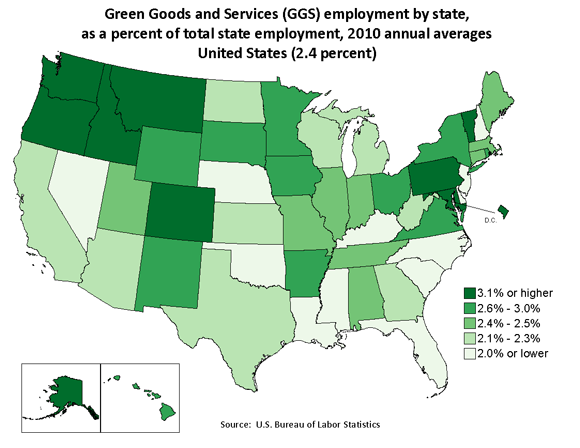An official website of the United States government
 United States Department of Labor
United States Department of Labor
In 2010, 3.1 million jobs in the United States (2.4 percent of total employment) were associated with producing green goods and services (GGS) that benefit the environment or conserve natural resources.
Among the states, Vermont had the highest percentage of its total employment in GGS jobs, at 4.4 percent, followed by the District of Columbia at 3.9 percent, Idaho at 3.7 percent, and Alaska and Maryland (3.6 percent each).

[Map data]
Those states with the lowest percentage of total employment in GGS jobs were Florida, at 1.3 percent, followed by Oklahoma at 1.5 percent.
The private sector had 2,268,800 GGS jobs in 2010, representing 2.1 percent of private industry employment. Among industries, the utilities industry accounted for the highest percentage of its total employment (551,287) in GGS jobs—11.9 percent, or 65,700 jobs. The financial activities industry had 190 GGS jobs, representing the lowest amount and percentage of total employment (0.0), among all industries.
The manufacturing industry had the greatest number of GGS jobs (461,800), or 4.0 percent of manufacturing employment. Construction had 372,100 jobs, comprising 6.8 percent of construction employment. Professional, scientific, and technical services had 349,000 jobs, accounting for 4.7 percent of the industry's employment.
The public sector had 860,300 GGS jobs in 2010, or 4.0 percent of public sector employment. Local government had the largest portion of GGS employment in the public sector (476,500 jobs)—representing 3.4 percent of the industry's employment.
The GGS employment data are compiled through the Green Goods and Services survey under the Quarterly Census of Employment and Wages program. The GGS survey includes approximately 120,000 business and government establishments within 333 industries that are identified as potentially producing or providing green goods or services. Establishments in the sample report whether they produced green goods and services and the percentage of their revenue or employment associated with that output. Those percentages are multiplied by their employment to derive the number of GGS jobs for the establishment. To learn more, see "Employment in Green Goods and Services — 2010" (HTML) (PDF), news release USDL-12-0495.
Bureau of Labor Statistics, U.S. Department of Labor, The Economics Daily, Employment in green goods and services, 2010 at https://www.bls.gov/opub/ted/2012/ted_20120327.htm (visited January 06, 2026).

